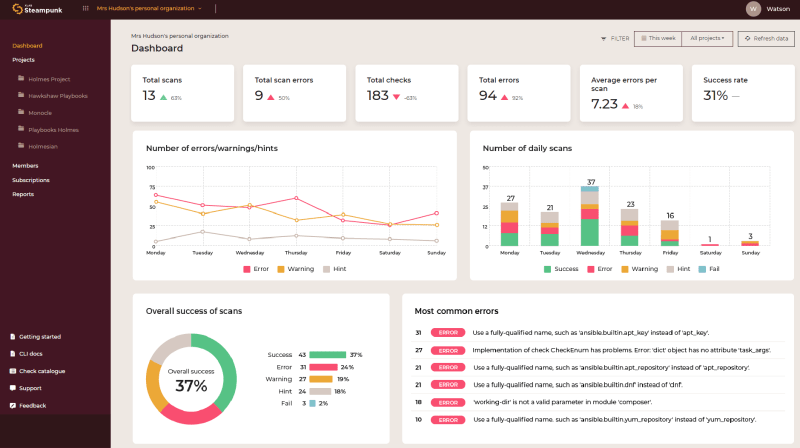Compliance is a critical aspect of IT operations. It’s important to ensure that your Ansible Playbooks are compliant with all relevant regulations and standards, or your business can suffer serious consequences, reaching far beyond just technical issues. But as your infrastructure grows, it gets harder and harder to keep playbooks compliant.
In this blog post we’ll explain why it’s so important and how to achieve compliance effectively and without hassle.
Let’s get started!
Why is compliance important?
If your playbooks are not compliant, you can expect a number of serious negative consequences, such as:
- Data breaches
- Security risks
- Operational disruptions
- Legal and regulatory penalties
- Increased cost
All these problems can also lead to financial losses and reputational damage, potentially jeopardizing customer trust and your key partnerships. It is crucial for businesses to prioritize compliance in IT processes to mitigate these risks.
And while ensuring compliance may seem complex, it actually doesn’t have to be. Not if you approach it intelligently and efficiently. Read on to find out how.
How to ensure compliance?
Here are the steps you need to take:
- Define your compliance requirements
- Use approved Ansible roles and modules in playbooks
- Test your playbooks
- Ensure compliance enforcement
- Monitor regularly
- Efficiently manage playbooks
We all know the theory, right? But how to keep up with all the rules and changes when dealing with a complex and constantly growing IT environment?
Using playbook management platform like Steampunk Spotter makes it remarkably simple. Spotter has a variety of features ranging from thorough playbook scanning and analysis to assuring compliance. Let’s explore each step and see how Spotter can assist you.
1. Define your compliance requirements
Which rules and standards do you need to follow? Once you have a clear picture of your requirements, you can start making sure your playbooks align with them.
Spotter’s Custom rules feature allows you to incorporate your own unique policies into the scanning process. So, when you run a scan, Spotter not only check for general best practices and security standards, but also for compliance with your own specific rules. And the best part is that you can do this with a universal OPA framework and a human-readable language called Rego, making it accessible even for non-tech folks. 😉
2. Use approved Ansible roles and modules in playbooks
When writing playbooks, it’s crucial to make sure the modules you’re using are safe to run and appropriate to use in your environment.
Interested in Spotter, but don’t know how to start? Explore our Getting started guide.
3. Test your playbooks
Before deploying your playbooks to production, make sure to test them thoroughly to ensure they function as expected and comply with your requirements.
Use Spotter’s playbook scanning feature which executes a comprehensive in-depth analysis of your playbooks. It’s like having an Ansible expert review your playbooks for compliance and guide you through the process of shaping them up if needed.
4. Ensure compliance enforcement
You can set up all the rules, include them as custom checks, and even tell developers to always run playbook scans. But sometimes, playbook writers might try to ‘overlook’ an issue to save time, even if it means sacrificing compliance. To prevent this, you can use Spotter to enforce specific checks. This means that a check marked as enforced can’t be ignored, no matter what any Ansible developer tries to do.
Spotter also supports organization-wide configuration, so the organization admin can decide which checks are always enforced.
5. Monitor regularly
Even if your playbooks are flawless at the moment, they may not stay that way forever. Ansible evolves, modules can become outdated, and your own security rules might change. To maintain compliance and security of your playbooks, regular monitoring is crucial. Once your playbooks are live, it’s important to keep an eye on them to make sure they’re still in line with your requirements.
We recommend you schedule automatic nightly CI runs with Steampunk Spotter to ensure the playbooks are in a healthy state, and the Ansible infrastructure is functioning correctly.
This will save you a lot of time by fixing problems as soon as they arise, instead of dealing with a whole bunch of issues at once. Plus, Spotter keeps track of how your playbooks are performing over time and identifies trends or anomalies.
6. Efficiently manage playbooks
For regular monitoring, you need a platform that brings all scan results together in one place, giving you a clear overview of your automation landscape’s overall health. Spotter provides a Dashboard, your go-to control panel for monitoring and managing the performance, security, and compliance statuses of your playbooks. It also generates comprehensive reports on playbook conditions, offering valuable insights into potential areas for improvement.
Team members working on the same Ansible project gain visibility into how each change within the Ansible Playbooks affects the overall validity, quality, and security of the project. Spotter platform enables developers to focus on scanning results, while managers can gain insights to optimize automation. Learn more about the visibility and collaboration offered by the Spotter app in this video.
To sum up
Ensuring compliance in your playbooks is an essential part of managing a secure and efficient infrastructure. Steampunk Spotter makes it easy by making compliance an integral part of your automation workflow, which means less hassle for both developers and managers. Give it a try!
Additional resources
Custom policies: Spotter takes you on a customizable automation journey
Ansible Playbook development: Step-by-step guide
Spotter app: Keep track of scan history and collaborate with your team










Top comments (0)